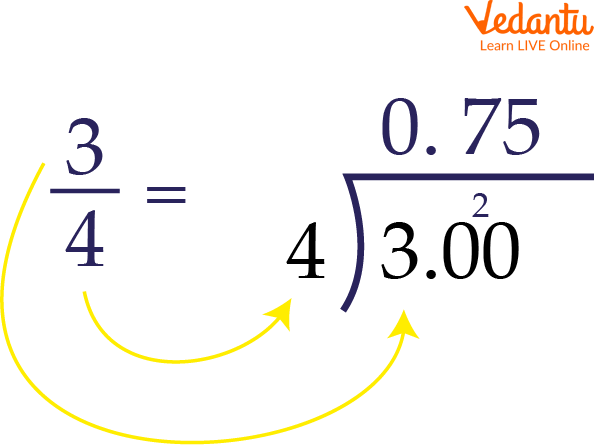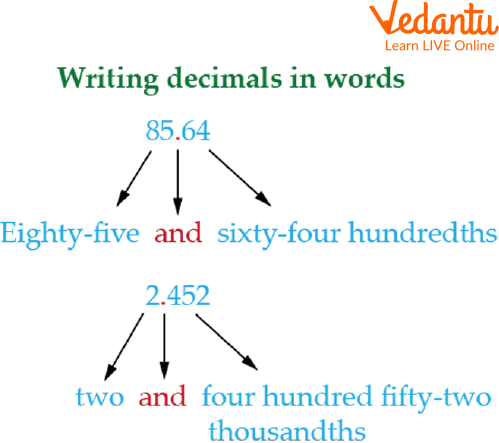




Diving Deep into the Decimals
We use decimals everyday while dealing with money, weight, length etc. Decimal numbers are used in situations where more precision is required than the whole numbers can provide. Numbers play a very vital role in Mathematics as well as our daily life. When we deal with fractions, sometimes their addition and subtraction get difficult to calculate. Hence there comes a need to convert fractions into the decimals or decimal numbers into their standard form. Let us study them in detail.

Introduction to decimal numbers
What is a Decimal?
A decimal is a number that means part of a whole. For example, the digit, or number, in front of a decimal represents a whole number. Let's say you have one apple; we would write that as 1.0. However, if you only have half of the apple, we can write that in decimal form by saying 0.5.
To express in decimal form, divide the numerator(top) by the denominator (bottom) like we simply do in the division.
For example, when we have a fraction say:
$\dfrac{2}{5}$ means $2 \div 5$, which is 0.4.

How to convert fractions into decimals.
Sometimes fractions get converted into repeating decimals. A decimal in which one digit after the point is repeated infinitely is called a “Recurring decimal”.
For example, $\dfrac{2}{3}$ can be expressed in decimal form as 0.6666…. (where the number 6 after the point repeats infinitely). These are called recurring decimals. Repeating decimals or Recurring Decimals are often rounded to the nearest hundredth.
Here $\dfrac{2}{3}$ rounds to 0.67. Always remember,‘The first space to the right of the decimal point is its tenth place, the second space is the hundredth place, and the third is the thousand place, and so on..' Here, 0.666….. rounds to 0.67hundredths place.
0.2222….will round to 0.23 and so on.
How to Write Decimals into Words?
Let us make the concept of writing a decimal into words easy. Here we will know how to write the decimal into a word using the example below-
85.64 will be written as Eighty-five and sixty-four hundredths.
Now let us see step by step how to convert a decimal into words-
Step 1- First of all read the digits to the left of the decimal point as a whole number.
Step 2- Say, ‘and’ for the decimal point.
Step3- Read the digits to the right of the decimal point as a whole number.
Step 4- Say the place of the last digit on the right.

Decimal into words
For example, write the following decimal numbers 85.64 in words.
First, read the digits to the left of the decimal number as a whole number. Here it reads, ‘Eighty-five’.
Say ‘and’ for the decimal point.
Read the digit to the right of the decimal point as a whole number. Here it reads, sixty-four.
Now add the place of the last digit on the right i.e, hundredths.
So 85.64 will be read as ‘Eighty-five and sixty-four hundredths’.
Some more examples:
827.960 will be read as, Eight hundred twenty-seven and nine hundred sixty thousand.
0.002 will be two thousandths.
Standard Form of a Decimal Number
Did you know that the distance between the earth and the sun is 150.24 million km which is a huge number to read? So we use millions or billions to make the number simple to read. That’s why we use a standard form to read, write and use the decimal number in many ways.
‘Any number that can be written as a decimal number between 1.0 and 10.00 multiplied by a power of 10 is said to be Standard Form of a Decimal number’.
Let us see some examples on the Standard form of a decimal number.
For example, $1,23,000$ can be written as $1.23 \times 10^5$.
If you observe carefully $1.23$ is a decimal number between $1.0$ to $10.00$.
Example- How to express 81,9000 in standard form,
Step1- Write the first digit, 8.
Step2- Add a decimal point after the first number and write the remaining non-zero number i.e, 8.19.
Step3- now count the number of digits after 8 . There are 5 digits after 8 .
So we write it as $8.19 \times 10^5$.
How to Write the Expanded Form of a Decimal Number?
The expanded form of a decimal number is a way to write the number using the place value of each digit. To write the expanded form of a decimal number, you need to break it down into its individual digits and place them in their respective place value positions.
Here is an example of how to write the expanded form of the decimal number 5.678:
5.678 = 5 + (0.6) + (0.07) + (0.001)
In this example, the expanded form of the decimal number 5.678 is 5 + 0.6 + 0.07 + 0.001. The 5 is in the ones place, the 6 is in the tenths place, the 7 is in the hundredths place, and the 8 is in the thousandths place.
Another example, The expanded form of the decimal number 123.456
123.456 = 100 + 20 + 3 + (0.4) + (0.05) + (0.006)
In this example, the expanded form of the decimal number 123.456 is 100 + 20 + 3 + 0.4 + 0.05 + 0.006. The 1, 2 and 3 are in the hundredth place, the 4 is in the thousandths place, the 5 is in the ten-thousandths place and the 6 is in the hundred-thousandths place.
You can use this method to write the expanded form of any decimal number, just make sure to place each digit in the correct place value position.
Solved Questions
Q 1. How do you express $\dfrac{4}{7}$ as a decimal?
Ans: To convert fraction $\dfrac{4}{7}$ into decimal, we divide 4 by 7.
$\dfrac{4}{7} = 4 \div 7$
=0.57
Hence, the decimal form of $\dfrac{4}{7}$ is 0.57.
Q 2. How do we write- 9.2, 74.5, 68.9 in words?
Ans: To write decimals into words,
9.2 = Nine and two tenths.
74.5 = Seventy four and five tenths.
68.9 = Sixty eight and nine tenths.
Practice Questions
Q 1. How to write the following decimal number 700.14 into words?
Ans: Seven hundred and fourteen hundredths.
Q 2. Expand form of the decimal number 305 is?
Ans: 305=300+05
Q 3. How do we convert $\dfrac{2}{7}$ in decimal form?
Ans: $\dfrac{2}{7}$ =0.285.
Summary
In this article, we learned about how Every day, we deal with decimals while dealing with money, weight, and length. When greater precision is required than whole numbers can give, decimal numbers are utilized converting fractions into decimals makes the operation easy and difficulty-free. The decimal form of a fraction, the standard form of a decimal number, and the expanded form of a decimal number are all very basic steps to learning and implementing mathematics. If you understand the concept thoroughly you can easily read and write decimal numbers.
FAQs on Introduction on How to write Fractions in Decimal Form
1. What is a decimal fraction and how is it written?
A decimal fraction is a fraction where the denominator (the bottom number) is a power of 10, such as 10, 100, 1000, and so on. When we write these fractions using a decimal point (.), they become decimal numbers. For instance, the fraction 5/10 is written as the decimal 0.5, and the fraction 25/100 is written as 0.25.
2. What is the main method to convert any fraction into its decimal form?
The primary method to convert a fraction to a decimal is to divide the numerator by the denominator. You can use the long division method for this. For example, to convert the fraction 3/4, you perform the division 3 ÷ 4. This gives the result of 0.75, which is the decimal form of the fraction.
3. Why are decimals important in our daily lives? Give some examples.
Decimals are crucial for precision in everyday situations where whole numbers are not sufficient. We use them constantly for:
- Money: To represent amounts like ₹50.75 (fifty rupees and seventy-five paise).
- Measurements: To record a person's height as 1.65 metres or the weight of groceries as 2.5 kilograms.
- Temperature: To state a precise body temperature, such as 98.6°F.
4. What is the difference between the 'tenths' and 'hundredths' place in a decimal number?
The position of a digit after the decimal point determines its value. The tenths place is the first digit to the right of the decimal point, representing parts of 10 (e.g., in 0.4, the 4 means 4/10). The hundredths place is the second digit, representing parts of 100 (e.g., in 0.45, the 5 means 5/100). Therefore, a digit in the tenths place is ten times more valuable than the same digit in the hundredths place.
5. How are fractions and decimals just two different ways of representing the same value?
Fractions and decimals are two different notations for representing numbers that are parts of a whole. A fraction, like 1/2, shows this relationship with a numerator and a denominator. A decimal, like 0.5, shows the exact same value using a place value system with a decimal point. Converting a fraction to a decimal does not change its value; it only changes the way we write it, similar to writing 'half' versus '50%'.
6. How do you correctly read and write a decimal number in words?
To read a decimal number, you follow three steps: First, read the whole number part to the left of the decimal. Second, say the word 'and' for the decimal point. Third, read the number to the right of the decimal as a whole number, and finish by saying the place value of the last digit. For example, the number 8.45 is read as "Eight and forty-five hundredths" because the last digit, 5, is in the hundredths place.
7. Can terminating and non-terminating decimals both come from fractions?
Yes, both types of decimals can be formed by converting fractions. A terminating decimal is one that ends, like 1/4 = 0.25. This usually happens when the fraction's denominator has prime factors of only 2 and 5. A non-terminating repeating decimal is one that goes on forever in a pattern, like 1/3 = 0.333.... This occurs when the denominator has prime factors other than 2 or 5.









